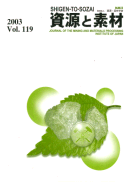All issues

Successor
Volume 119, Issue 1
Displaying 1-5 of 5 articles from this issue
- |<
- <
- 1
- >
- >|
Current Opinion
-
Etsuro YAMADA2003Volume 119Issue 1 Pages 1-8
Published: 2003
Released on J-STAGE: March 31, 2006
JOURNAL FREE ACCESSThis paper is reviewed on the effective thermal conductivity of dispersed materials based on previous author's papers.
The main articles represented in this review are as follows:
(1) The various factors affected on effective thermal conductivity are listed.
(2) The main approaches to research conductivity are explained with methods and models.
(3) The effectiveness affecting to conductivity are evaluated by using various models and processes.
(4) Representative predicting equations of effective thermal conductivity are tabled and evaluated by comparing between predicted values and experimental results.View full abstractDownload PDF (662K)
Original Paper
-
Hae-Sik JEONG, Yuzo OBARA, Katsuhiko SUGAWARA2003Volume 119Issue 1 Pages 9-16
Published: 2003
Released on J-STAGE: March 31, 2006
JOURNAL FREE ACCESSIn order to investigate the environmental dependence on strength of rock, uniaxial compression test and Brazilian test under water vapor environment were conducted on Kumamoto andesite and Kitagishima granite. Tests were carried out under various water vapor pressures, which are controlled in special chambers, at a constant strain rate. The results obtained by the uniaxial compression test and Brazilian test are follows:
The Young's moduli are almost constant with the change of water vapor pressure. On the other hand, the water vapor pressure largely affects the uniaxial compressive strength and the tensile strength of rock. Namely, the strengths of rock increase with decreasing water vapor pressure.
The relationships between uniaxial compressive strength Sc , tensile strength St and water vapor pressure p can be represents by the following equation: long Sc ∝ -Nc log p and long St ∝ -Nt log p, where Nc and Nt are the inclination of lines.
Comparing the above equations based on the test results with equation (5), the stress corrosion indexes are obtained as 24 in Kumamoto andesite and 62 in Kitagishima granite on uniaxial compression test, then 58 in Kumamoto andesite on Brazilian test. It is discussed that the difference between the stress corrosion indexes obtained from uniaxial compression test and Brazilian test is caused by the stress state within rock specimen in each test.
The estimation method of long term-strength of rock is shown according to equation (8), then the long-term strength of Kumamoto andesite and Kitagishima granite can be estimated concretely, that is, uniaxial compressive strengths of Kumamoto andesite and Kitagishima granite after 1000 years are estimated 75% and 89% of uniaxial compressive strengths at the present time respectively.View full abstractDownload PDF (1207K) -
Fumio TANNO, Kenji MATSUZAKI, Akio FUWA2003Volume 119Issue 1 Pages 17-22
Published: 2003
Released on J-STAGE: March 31, 2006
JOURNAL FREE ACCESSA simulation model of the Imperial Smelting Furnace has been developed to improve the furnace operation. The model consists of top, shaft and bottom regions. Analysis in the shaft region is based on differential heat and materials balances taking account of reaction kinetics and heat transfer rate, and those in the top and the bottom regions are based on heat and materials balances under steady-state condition. Overall heat and materials balances, and longitudinal distributions of process variables such as temperatures of gas, sinter and coke, volume-flow rate of gas, mass-flow rates of sinter, coke and molten lead, gas composition and fractional conversion in the shaft region under a practical operating condition were calculated. The heat loss through the furnace wall and the temperature distribution calculated using the model are in good agreement with those observed. The model is capable of predicting any change in the furnace situation when the operating condition is altered.View full abstractDownload PDF (1291K) -
Fumio TANNO, Kenji MATSUZAKI, Akio FUWA2003Volume 119Issue 1 Pages 23-25
Published: 2003
Released on J-STAGE: March 31, 2006
JOURNAL FREE ACCESSUsing the simulation model of the Imperial Smelting Furnace based on differential heat and materials balances developed by the authors, the behavior of ISF under various operating conditions was predicted, where the influence of change in an operating condition on furnace performance was estimated. The main findings are as follows:
(1) With decreasing coke reactivity, zinc productivity increases and coke ratio decreases.
(2) There are an optimum size of particle and an optimum height of charge for the furnace performance.
(3) Pulverized coke injection improves the furnace performance.
Analysis of furnace performance using the model is useful for further improvement of the furnace operation.View full abstractDownload PDF (431K)
Technical Report
-
Hiroshi UESUGI, Yasuyuki YAMAGUTI, Takako YAMASITA, Masayosi AMATATU2003Volume 119Issue 1 Pages 27-31
Published: 2003
Released on J-STAGE: March 31, 2006
JOURNAL FREE ACCESSTank sludge forms and accumulates in oil tanks which are used to store crude oil, heavy oil and half-finished oil when such materials are stored over an extended period of time. Although tank sludge has conventionally been disposed of by incineration, a technology for recycling this material was developed and a solidified fuel was obtained.
The solidified fuel is produced by mixing by-products (sludge of coke,carbonized RDF) and industrial waste (inorganic sludge) discharged from industrial complexes with tank sludge at an appropriate blending ratio. This material can be processed into a solidified fuel which has excellent handling and storage characteristics, combustion properties, and economy.View full abstractDownload PDF (1316K)
- |<
- <
- 1
- >
- >|